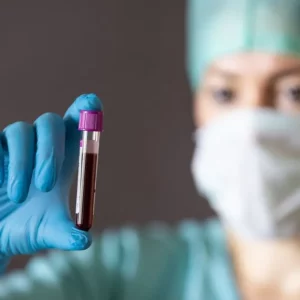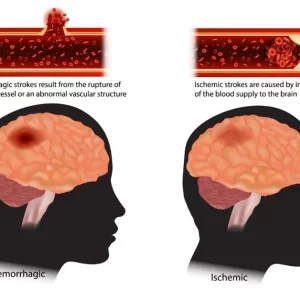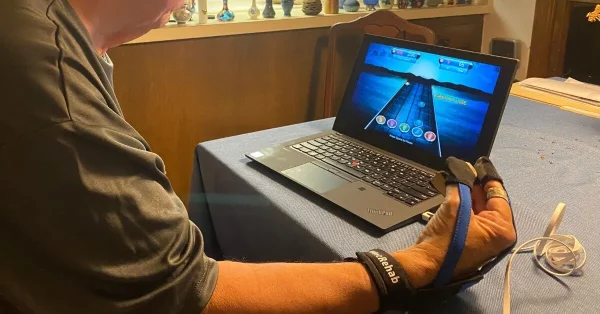Experiencing a cerebellar stroke is rare, as this specific type accounts for just 1-4% of all strokes. While uncommon, cerebellar stroke can lead to various secondary effects that impact a survivor’s daily life. However, if you have experienced a cerebellar stroke and are seeking information on cerebellar stroke recovery, it’s essential to know that this condition can lead to a wide variety of secondary effects that can impact daily function. For this reason, survivors must be diligent about asking the right questions and continually pursuing recovery.
To help prepare you for the recovery journey, we will review the initial symptoms and unique secondary effects that may occur after a stroke in the cerebellum. We will also discuss the best practices for rehabilitation to maximize your gains in function. Additionally, we will cover a rough timeline to help you ask educated questions when you visit your doctor.
To help you navigate this article, feel free to use the following jump links:
Initial Symptoms of Cerebellar Stroke
A stroke occurs when the supply of blood to the brain is compromised. This can be caused by a blocked artery in cases of ischemic stroke or a burst artery in cases of hemorrhagic stroke. While cerebellar stroke makes up a small percentage of yearly strokes, it is associated with a high mortality rate. This is because of the cerebellum’s location and its functions.
It is important to familiarize yourself with the hallmark symptoms of a stroke to help protect yourself or a loved one. These symptoms can include facial drooping, weakness in one arm, and slurred speech. However, cerebellar stroke often presents with different symptoms. Since all stroke symptoms should be interpreted as a medical emergency, let’s review the additional signs and symptoms of cerebellar stroke:
- Vertigo
- Nausea or vomiting
- Dizziness
- Lethargy
- Headache
- Muscle weakness or paralysis
- Vision problems
Vertigo in Cerebellar Stroke
Around 1-3% of people rushed to the emergency room for vertigo are actually having a cerebellar stroke. Since vertigo can be caused by other conditions, this leads to a high misdiagnosis rate, meaning cerebellar stroke is often missed initially. This significantly increases the risk of mortality due to cerebellar stroke and can lead to more severe secondary effects when this goes undiagnosed and untreated.
Two symptoms that can help physicians detect cerebellar stroke in cases of vertigo are ataxia and nystagmus. Ataxia refers to uncoordinated movements or poor control of the muscles and limbs. This can present as difficulty balancing, the inability to walk unsupported, impaired fine motor skills, and language changes. Nystagmus is an involuntary movement of the eyes, often in a fast rhythmic or repetitive manner.
These two signs are especially indicative of a cerebellar stroke. For this reason, physicians should be encouraged to order brain scans when patients show signs of vertigo, especially when combined with ataxia and nystagmus. Now that we have discussed initial cerebellar stroke signs, let’s talk about the cerebellum itself and the potential effects of a stroke in this area of the brain.
Secondary Effects of Cerebellar Stroke
The cerebellum is located at the back of the brain, just behind the spinal cord and below the main cerebrum. Generally, the cerebellum is known to control the coordination of voluntary movements, maintenance of balance and posture, motor learning, and some aspects of language. Therefore, when a stroke occurs in the cerebellum it can damage any or all of these functions.
Cerebellar strokes often lead to impairments in motor control and posture because the majority of the cerebellum’s outputs are to the motor system. The cerebellum does not initiate movement but rather sends signals that help coordinate and control movement. To help you better understand what to expect, here are the most common secondary effects of cerebellar stroke:
Secondary Cerebellar Stroke Effects
- Acute cerebellar ataxia: A sudden lack of control over voluntary movements.
- Loss of coordination and balance: This is closely related to ataxia and affects functional movements and self-care tasks.
- Vertigo: The feeling that the world is spinning around you.
- Nausea and vomiting: This effect can stem from other cerebellar stroke effects like vertigo.
- Cerebellar cognitive affective syndrome: This condition involves executive function, language processing, and visuospatial impairments. This can affect a survivor’s mental state and behavior.
- Impaired memory: Cerebellar strokes can impair a survivor’s working or short-term memory.
- Difficulty with proprioception: This refers to trouble pinpointing how your body is moving or where it is located in relation to the world around you.
- Speech problems: This includes conditions like aphasia or slurred speech.
- Eye movement disorders: Double vision and nystagmus are common following cerebellar stroke and can contribute to dizziness.
Due to the wide range of secondary effects after cerebellar stroke, survivors must work closely with their rehab team. These rehab experts can help diagnose secondary effects and rehabilitate as much function as possible. Following inpatient and outpatient therapy, survivors must also participate in therapy exercises at home to maintain and progress their function. Before we discuss rehabilitation methods for cerebellar stroke recovery, let’s explore the recovery prognosis.
Prognosis for a Stroke in the Cerebellum
Regarding stroke recovery, only one thing is certain: every stroke is different and every recovery will be different. Since everyone’s brain is wired uniquely, every stroke survivor experiences unique effects. Although it’s hard to predict the outcome of any single stroke, there are a few main things that will affect the prognosis:
- The size of the stroke: This refers to the amount of brain tissue that was damaged due to the stroke. This is sometimes determined by how quickly emergency care is accessed after stroke onset.
- The area of the brain affected by stroke: Different areas of the brain, including different areas of the cerebellum, are responsible for different functions. Therefore, the specific area of the brain that is impacted will determine the resulting effects. Additionally, multiple lobes of the brain can be affected by a singular stroke.
- The consistency and effectiveness of rehabilitation: Consistency with a targeted rehab program plays a major role in recovery. While this depends heavily on stroke severity, rehabilitation can improve the recovery outlook for many.
- The survivor’s prior level of function: Pre-existing medical conditions and impairments can negatively impact recovery outlook. The healthier and more independent the survivor was before their stroke, the better their prognosis for recovery will likely be. Additionally, living situations can have an impact on recovery.
Since stroke recovery can be impacted by so many factors, it is vital to work closely with your medical team. They will be able to answer your questions and tailor your rehabilitation program to meet your unique needs. For instance, you can gain insight into the size and severity of your stroke by asking about your NIH Stroke Scale. Your medical team can help you better understand this information and create a meaningful recovery program that helps you reach your goals.
Cerebellar Stroke Rehabilitation Methods
The appropriateness and intensity of rehabilitation make a big difference in recovery. While every stroke recovery timeline will be different, taking the right steps can help patients maximize their outcomes. To create a plan that addresses your unique impairments and goals, you will likely interact with several different types of therapy experts and techniques.
The foundation of cerebellar stroke recovery is neuroplasticity, which is the brain’s automatic ability to heal and improve neural pathways. When brain tissue is damaged due to stroke, neuroplasticity allows healthy areas of the brain to take over function from damaged areas. This occurs through high repetition of therapy exercises, which helps create these new pathways. To encourage this, here are some of the best practices for cerebellar stroke rehabilitation.
Rehabilitation Best Practices
- Physical therapy. Physical therapy can help retrain the brain to improve coordination after cerebellar stroke. Additionally, a PT can help you increase your strength, prevent muscle atrophy, and regain the ability to walk.
- Occupational therapy. If poor coordination, balance, and other impairments from cerebellar stroke have impacted your ability to engage in activities of daily living, occupational therapy can help. This includes activities like dressing, showering, and cooking. OTs can also help you improve fine motor control and hand function after stroke.
- Speech therapy. When cerebellar stroke survivors are affected by language difficulties like aphasia or ataxia of speech, speech therapy can help. A speech-language pathologist (SLP) can diagnose your condition and create an exercise plan suited to your specific needs. Additionally, they can address dysphagia, or difficulty swallowing after stroke.
- Core and balance training. Physical therapists may recommend specific core and balance exercises for cerebellar stroke survivors to practice. This can help improve a survivor’s safety and independence both at home and in the community.
- Cognitive training. If an executive function like memory has been affected, then cognitive training exercises may help. Apps like the CT Speech & Cognitive Therapy App can help address both speech and cognitive training. Your occupational and speech therapists can provide additional resources for cognitive training.
- Vision training. When vision has been affected, it is sometimes possible to partially regain your sight after a stroke through vision training. This involves practicing specific eye exercises such as visual scanning. The goal is to stimulate the brain and improve the brain’s ability to process visual input. A neuro-optometrist is another great resource if you are affected by vision problems after cerebellar stroke.
Consistency and High Repetition
As we discussed previously, consistency and high repetition are key for making lasting improvements after stroke. A great way to stay motivated during recovery is to use interactive home therapy devices like FitMi. FitMi helps you accomplish high repetition of therapeutic exercises and engage neuroplasticity. When used regularly, recovery tools like this can help survivors see faster improvement in function. However, stroke recovery will still be a lengthy process. In the next section, we will discuss this timeline in more detail.
Cerebellar Stroke Recovery Time
No one can say with certainty how long it takes to recover from cerebellar stroke. Every stroke is different and, therefore, every stroke recovery timeline is unique. However, the timeliness and intensity of rehabilitation make a huge difference in a survivor’s outcome.
3-6 Months
During the first 3-6 months after stroke, the brain is in a heightened state of plasticity. This increased neuroplasticity leads to more rapid improvement in function, which is often referred to as spontaneous recovery. This is also the period when survivors engage in inpatient therapy. Inpatient therapy is intensive and requires hours of therapy each day. This intense workload is another reason why stroke patients tend to recover rapidly in the beginning.
After 6 Months
Unfortunately, the lack of adequate home therapy is one reason why many stroke patients are at the same level of recovery at the 5-year mark as they were at the 3-month mark. When recovery begins to slow, some survivors may become discouraged about the slower rate of progress. Additionally, many survivors will experience a plateau or even regression in function at some point in their recovery journey. This can cause a survivor to abandon their rehab program altogether.
While a plateau or regression can be discouraging, it is important to know that this is natural, and that progress can still be made. In fact, we know that improvement is always possible, even years after stroke. For this reason, it is crucial to continue pursuing recovery and working hard to reach your goals.
Cerebellar Stroke Recovery
While cerebellar stroke is rare, it can be accompanied by severe secondary effects that impact many aspects of a survivor’s daily life. The most common secondary effects of cerebellar stroke include poor balance, decreased movement coordination, speech impairments, and changes in hearing or vision. Fortunately, a dedicated rehabilitation program can help patients recover from these secondary effects and improve daily function.
How much recovery cerebellar stroke survivors will achieve is uncertain. However, the brain is capable of amazing things. When the cerebellum is damaged due to stroke, recovery is possible through neuroplasticity. This rewiring of connections can be maximized through consistent practice of rehab exercises and a lifelong pursuit of recovery.
Cerebellar stroke recovery is a lifetime process and there will be highs and lows along the journey. The most important piece of recovery for survivors is to continue creating meaningful goals and taking small steps toward improvement. We hope this article has helped explain cerebellar stroke and how survivors can pursue recovery one day at a time.









